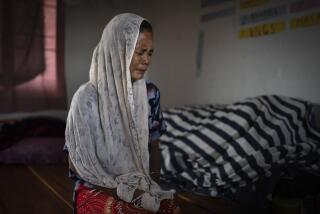In India, a fight for lower status
- Share via
SIKANDARA, INDIA — Sitting in the middle of a highway under a baking hot sun is not Mansingh Burja’s idea of a good time. But it’s the best way, he says, for him and hundreds of fellow protesters to vent their anger over being classified by the government as a “backward” class near the bottom of India’s social ladder.
They want to be lower.
The demonstrators, members of an ethnic group known as Gujjars, have blocked traffic for two weeks here on the road leading to the famed Taj Mahal, ever since dozens from their ranks were killed in a hail of bullets during clashes with state police. They vow to remain where they are until the government reclassifies them, putting them at the bottom of the official social hierarchy.
Such a move would in essence drop the Gujjars to a level similar to that of India’s former “untouchables,” who were pariahs under the ancient caste system. But it also would entitle them to more favorable quotas in education and public-sector jobs that the government has set aside for the nation’s most oppressed and least modernized groups in an effort to redress historic wrongs.
It is the world’s largest affirmative-action program, and the Gujjars say they deserve their fair share of it.
“Our community is just as backward” as the former untouchables, declared Burja, 32. “We need the same kinds of benefits.”
He and his fellow demonstrators have brought life to a standstill in a large swath of Rajasthan, a state in western India popular with tourists for its imposing desert forts and picturesque cultural life.
The protesters bivouacked in the middle of the highway here have cut off the link between the city of Jaipur, about 30 miles away, and Agra and the Taj Mahal, a key artery not just for tourists but for movement of goods. Gujjar women have sat down on train tracks and disrupted rail service.
The demonstrators also have destroyed public property, pulling down stoplights and ripping out highway guardrails to fling onto the pavement as roadblocks alongside uprooted trees, boulders and the charred frames of burned-out motorcycles. Economic losses stemming from two weeks of protest are estimated at more than $1 billion.
Nobody anticipated such a violent response from state police, who fired on protesters in at least three incidents, beginning May 23. When the clashes subsided a few days later, 43 people were dead, nearly all of them Gujjars. Autopsies reportedly suggest that some had been shot in the back.
The dead included 20 people from this town alone, all but two of them young men. Their bodies, packed in ice, lay in a row of crude wooden coffins here on the highway in Sikandara, a Gujjar stronghold, as a sign of protest. The remains finally were cremated Saturday.
Rajasthan’s government has been widely condemned for its bloody crackdown, with the central government describing the situation as a “complete collapse of law and order.” The state’s top elected official, Chief Minister Vasundhara Raje, took out half-page ads in national newspapers last week admonishing people that it was “not the time for allegations and counter-allegations.”
Along with harsh criticism over her handling of the protests, there has been criticism of the reservation program that is at the root of the Gujjars’ agitation.
However well-intentioned, government quotas have sharpened caste divisions rather than healed them, critics say, and encouraged “a race to the bottom” as groups such as the Gujjars clamor to be recognized as more disadvantaged than others in order to qualify for a larger pool of benefits and quotas, known here as reservations.
What began as a program specifically intended to remedy discrimination against untouchables -- those shunned as ritually unclean in the Hindu caste system -- and the isolation of indigenous tribes has morphed into a tool of political patronage for parties hoping to win votes by promising to extend benefits to one poor community or another.
“Unfortunately, somewhere down the line we took our eye off the ball and we began to equate reservations with anti-poverty policies. The two are quite distinct,” said Dipankar Gupta, an expert on caste at Jawaharlal Nehru University in New Delhi.
When the Gujjars began making their demand last year, they found themselves in conflict with another disadvantaged group, the Meenas, who saw the Gujjars as trying to muscle in on the benefits they enjoyed on Rajasthan’s bottom tier.
More than 20 people died in rioting. The confrontation ended when the state government agreed to review the Gujjars’ status as one of India’s so-called “other backward classes,” the second-lowest classification. A blue-ribbon panel’s recent recommendation that the Gujjars be given a $70-million aid package, but not the “Scheduled Tribe” status they sought, set off the new round of protests.
“Meenas have been enjoying this status for some time now. We’re in the same areas as they are, and we’re just as backward as them, and it didn’t make sense that they had this status and we didn’t,” said Nepal Singh Arya, 34.
A road-construction contractor who lives in Jaipur, he acknowledged that his button-front white shirt, jeans and sturdy leather shoes hardly painted the picture of backwardness.
Most Gujjars, though, are agricultural laborers and cattle herders, some too poor to own land.
“In Rajasthan, a lot of this community [are] in a dire situation,” said Sachin Pilot, a Gujjar member of Parliament, who noted that Gujjars in other parts of India, such as the Himalayan state of Jammu and Kashmir, have been granted the tribal status.
“Everybody wants a share of the pie, because India is on a growth trajectory,” Pilot said. For communities such as the Gujjars, he argued, the only way to get a foothold in an economy expanding 9% a year is through government intervention.
No one is predicting how the standoff will be resolved. The leader of the Gujjar movement says he is willing to open talks with the state government, but his followers remain defiant.
“The cops are constantly putting pressure on us, and the state government isn’t inclined to talk to us,” protester Burja said. “We’re fully prepared to face bullets and anything else that might happen.”
--
More to Read
Sign up for Essential California
The most important California stories and recommendations in your inbox every morning.
You may occasionally receive promotional content from the Los Angeles Times.











